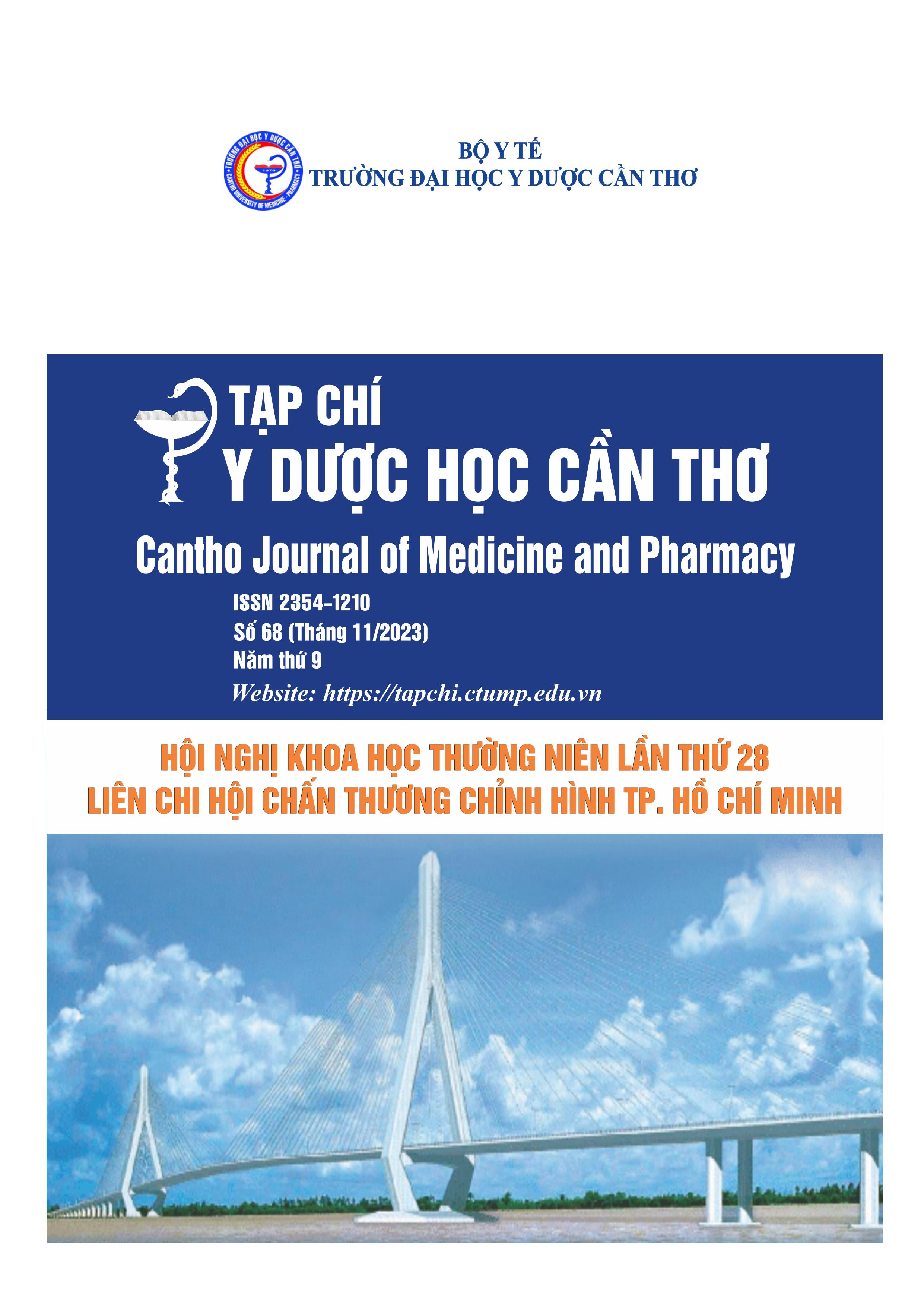EVALUATION OF THE FUNCTIONAL RESULTS AFTER ROTATOR CUFF ARTHROSCOPIC REPAIR WITH THE SUTURE BRIGDE TECHNIQUE AT HOSPITAL FOR TRAUMATOLOGY AND ORTHOPAEDICS
Main Article Content
Abstract
Background: The methods of repairing rotator cuff tear are single-row technique, traditional double-row technique, and suture-bridge technique. The focus of the treatment has been transferred from just treating rotator cuff tears to raising the healing rates. As a result, the suture brigde technique maximizes the contact area between the tendon and the tuberosity insertion footprint. Objectives: To evaluate the functional outcomes in patients who underwent arthroscopic rotator cuff repair using the suture-bridge technique in Hospital for Traumatology and Orthopaedics (HTO) in 2019-2022 followed by an early exercise physiotherapy regime. Materials and methods: A prospective analysis study on 79 patients who had only a supraspinatus tear treated arthroscopically for rotator cuff tears in HTO, Ho Chi Minh City, in 2019-2022. The functional outcome was assessed by two scoring systems, UCLA, and VAS scores. Post operatively, patients were immobilized for 3 weeks only. They were followed up at 4 weeks, 12 weeks and at 6 months. Results: Our study had 79 patients reporting a good outcome, whereas 10 patients had a fair outcome. The mean VAS scores improved from 7.57 to 2.97 whereas the UCLA score improved from 12.04 to 32.00. Conclusions: The arthroscopic suture-bridge technique resulted in acceptable patient satisfaction and functional outcome as 94.52% of our patients had a “good” outcome.
Article Details
Keywords
Arthroscopic cuff, Early physiotherapy, Suture-bridge technique
References
2. Haque, A. and H. Pal Singh, Does structural integrity following rotator cuff repair affect functional outcomes and pain scores? A meta-analysis. Shoulder Elbow, 2018. 10(3): 163-169, doi: 10.1177/1758573217731548.
3. Cho, N.S., B.G. Lee, and Y.G. Rhee, Arthroscopic rotator cuff repair using a suture bridge technique: is the repair integrity actually maintained? Am J Sports Med, 2011. 39(10) 210816, doi: 10.1177/0363546510397171.
4. Fealy, S., T.P. Kingham, and D.W. Altchek, Mini-open rotator cuff repair using a two-row fixation technique: outcomes analysis in patients with small, moderate, and large rotator cuff tears. Arthroscopy, 2002. 18(6): 665-70, doi: 10.1053/jars.2002.32589.
5. Lo, I.K. and S.S. Burkhart, Double-row arthroscopic rotator cuff repair: re-establishing the footprint of the rotator cuff. Arthroscopy, 2003. 19(9): 1035-42, doi: 10.1016/j.arthro.2003.09.036.
6. Park, J.Y., et al., Comparison of the clinical outcomes of single- and double-row repairs in rotator cuff tears. Am J Sports Med, 2008. 36(7) 1310-6, doi: 10.1177/0363546508315039.
7. Ren, Y.M., et al., Comparison of arthroscopic suture-bridge technique and double-row technique for treating rotator cuff tears: A PRISMA meta-analysis. Medicine (Baltimore), 2019. 98(20): e15640, doi: 10.1097/MD.0000000000015640.
8. Hoàng Mạnh Cường, Đánh giá kết quả sử dụng nội soi và đường mổ nhỏ điều trị rách chóp xoay. 2009, Đại học Y Dược TP. HCM.
9. Cicak, N., [Rotator cuff rupture]. Reumatizam, 2003. 50(2): 45-6.
10. Vo, A., et al., Physical Therapy and Rehabilitation after Rotator Cuff Repair: A Review of Current Concepts. International Journal of Physical Medicine and Rehabilitation, 2013. 1: 1-11.
11. Kelly, B.T., et al., Shoulder muscle activation during aquatic and dry land exercises in nonimpaired subjects. J Orthop Sports Phys Ther, 2000. 30(4): 04-10, doi: 10.2519/jospt.2000.30.4.204.
12. Hoàng Mạnh Cường, Báo cáo kết quả bước đầu ứng dụng nội soi khớp vai trong chẩn đoán và điều trị các thương tổn của chóp xoay. Tạp chí Y Dược Lâm Sàng 108, 2006. Số đặc biệt Hội nghị thường niên Hội Chấn thương chỉnh hình Việt Nam lần thứ 5: 70-73.
13. Cavalier, M., et al., Management of Massive Rotator Cuff Tears: Prospective study in 218 patients. Orthop Traumatol Surg Res, 2018. 104(8s): S193-s197, doi: 10.1016/j.otsr.2018.09.007.
14. Nguyễn Trung Hiếu, Kết quả điều trị rách chóp xoay qua nội soi bằng kỹ thuật khâu một hàng không cột chỉ. 2017, Đại học Y Dược TP. HCM.


